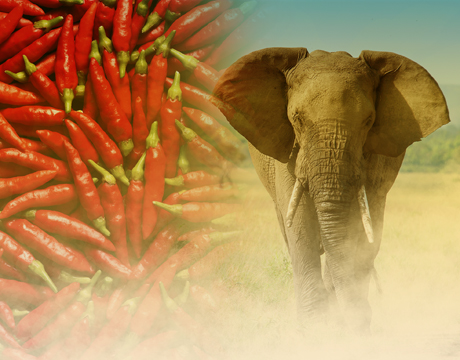No BS: Engineering Elephant Dung to Help African Farmers
No BS: Engineering Elephant Dung to Help African Farmers


Botswana is home to more than 130,000 African elephants, more than all other African countriescombined. Unfortunately, those elephants have begun exploring beyond the national parks, encroaching into areas where Botswanans live. This is a problem for people, since elephants that encounter human settlements fight with livestock for water and raid crops at night. Angry farmers will set traps or tip off poachers to the locations of elephants.
My teammates in the International Development Design Summit were each from different villages in Botswana. After a brainstorming session to identify the problems, we proposed developing a device for farmers to manufacture their own elephant repellent. We started with information from a local non-governmental organization called Ecoexist and found that elephants are afraid of fire, smoke, bees, and electricity. We knew that electric fences are too expensive for most small farmers and not culturally suitable to protect ranchers’ water points due to the practice of free range livestock in Botswana.
My team, composed of three locals and myself, got to work testing recipes for what we call a “chili briquette.” When burned, the smoke from the briquettes can turn away unwanted elephants. The bulk of the briquette is elephant dung itself, which is easily found close to villages where people gather firewood. The second ingredient gives the smoke an extra elephant-repelling kick — chili peppers. Cooked sorghum porridge, a common breakfast food, was used as a binding agent. After conducting user research, our team identified a need for the chili briquettes during the rainy season when farmers plow and the elephants come to eat the crops. Knowing this, we designed a mbaula (metal stove) out of a paint can with a lid for keeping the rain off the burning briquette.
Read More: Spray-On Antenna Could Signal the Future of Wireless
After testing the burning bricks, we identified a recipe that makes strong, irritating chili smoke and burns slowly to last all night. The chili briquettes use a ratio of 2:1 elephant dung to chili and a ratio of 20:1 elephant dung to soft porridge. The overall recipe is 20:10:1 dung to chili to porridge. This contains the right amount of chili to produce strong-smelling, irritating chili smoke, and the right amount of fuel and moisture in the chili bricks for them to dry quickly and to burn for a long time. According to the farmers who have tested bricks so far, five nights of continuous burning are enough for elephants to change their corridors and stay away from the fields.
The chili briquettes are such a cheap and simple solution they’ve generated a high demand for a business to make and sell them to farmers and ranchers. My team used sketch-modeling to design and iterate a press mechanism that could produce enough force to compress the briquettes on a commercial scale.
Importantly, my team members were not experts in engineering or design. But one goal of the International Development Design Summit is for participants to learn through trial and error. Accordingly, the first prototype we built was a wooden box that was hard to clean, made briquettes that were too small, and lacked the force to compress the briquettes properly.
Our team split into two after creating the first prototype. I worked on the stove and tested briquette recipes while others began building a second press. That press was larger, made from metal, and had a handle that raised and lowered a heavy concrete block into a removable mold. Upon testing, we found that this prototype was too expensive and mechanically inefficient to produce affordable and well-compressed chili bricks. After the summit, many participants reported that they felt empowered to continue applying the design process to solve everyday problems. Two team members even agreed to continue developing the technology in their home villages of Kaputura and Rakops.
There are now two new businesses in my teammate’s home villages of Kaputura and Rakops making and selling chili briquettes. The two innovation centers, established as part of the summit, will help the entrepreneurs with tools, design help, and business support as they scale up and protect many more elephants and humans from each other.
Listen to ASME TechCast: How Engineers Close Communication Gaps with Non-engineers
Anna Libey is an Engineering for Change Research Fellow and an environmental engineer, with a focus on water and sanitation for international development. For more articles on global development visit www.engineeringforchange.org.


.png?width=854&height=480&ext=.png)


.png?width=854&height=480&ext=.png)

